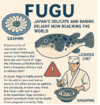
Jun 3, 2025
If you’re a fan of Japanese cuisine, you’ve likely tried sushi, ramen, or tempura. But have you ever heard of fugu—the infamous pufferfish that’s both a luxurious delicacy and a culinary dare?
In Japan, fugu is highly prized for its subtle taste and unique texture. It’s often served as sashimi, hot pot (nabe), or even deep-fried. But what really sets it apart is its reputation: fugu contains a potent neurotoxin that can be deadly if not prepared correctly. Only specially licensed chefs are allowed to serve it in Japan, making it not only a dish but a demonstration of craftsmanship and trust.
Outside Japan, however, fugu is often seen as “the dangerous fish.” In fact, many countries—including the EU, the UK, and Vietnam—ban its distribution due to safety concerns. But that perception is beginning to shift.
In recent years, Singapore has taken the lead in embracing fugu. Since 2022, not just the meat but also the creamy shirako (milt) and skin from farm-raised fugu have been legally served there. At restaurants like Genpin Fugu in downtown Singapore, locals now make up 60–70% of the clientele, enjoying fresh shipments from Japan’s Shimonoseki region. One local diner even said, “Eating fugu helps me recover after a long day at work!”
Japanese producers see great potential abroad. In addition to Singapore, talks are underway with Vietnamese and Taiwanese authorities about lifting bans. And with global demand for high-quality protein rising, especially in Asia, fugu’s future outside Japan looks promising.
For travelers and foodies interested in experiencing something both refined and rare, trying fugu in Japan—or at a trusted overseas location—is more than a meal. It’s a cultural adventure.
So next time you’re in Japan, why not take a seat at a fugu restaurant and discover why this mysterious fish continues to captivate locals and adventurous gourmets alike?
ふぐ:日本の繊細で大胆なごちそうが今、世界へ広がる
もしあなたが日本料理のファンなら、寿司やラーメン、天ぷらをすでに試したことがあるでしょう。でも、ふぐという名前を聞いたことはありますか?——高級な珍味でありながら、挑戦的な料理でもあることで有名な魚です。
日本では、ふぐはその微妙な味わいと独特の食感で高く評価されています。刺身、鍋(なべ)、さらには唐揚げとして提供されることがよくあります。しかし、この魚を特別な存在にしているのは、その評判です:ふぐは、正しく調理されなければ致命的となる強力な神経毒を含んでいます。そのため、日本では特別な免許を持つ料理人だけがふぐを提供することが許されており、それは単なる料理ではなく、職人技と信頼の証でもあります。
しかし、日本の外では、ふぐはしばしば「危険な魚」として見られています。実際、EU、英国、ベトナムなど多くの国では、安全上の懸念からふぐの流通が禁止されています。しかし、その見方は変わりつつあります。
近年、シンガポールはふぐの受け入れにおいて先頭を走っています。2022年以降、養殖されたふぐに限り、身だけでなく、クリーミーな白子や皮も合法的に提供できるようになりました。シンガポール中心部の「玄品ふぐ」などのレストランでは、日本の下関から届く新鮮なふぐを、今では客の60〜70%が地元の人々として楽しんでいます。ある現地の客は、「仕事で疲れた後にふぐを食べると元気が出ます」と語っています。
日本の生産者たちは、海外での大きな可能性を見ています。シンガポールに加え、ベトナムや台湾の当局とも輸入解禁に向けた協議が進んでいます。そして、特にアジアで質の高いタンパク源の需要が高まる中、ふぐの海外での将来は明るく見えます。
旅行者や食に関心のある人にとって、洗練されていて珍しいものを体験するなら、ふぐを日本で——あるいは信頼できる海外の店舗で——試してみるのは、食の冒険です。
次にあなたが日本を訪れるときは、ぜひふぐ料理店の席についてみてください。この神秘的な魚が、なぜ日本の人々や冒険好きな美食家たちを魅了し続けているのかがわかるはずです。
